List of rifle cartridges , by primer type, calibre and name.
Contents
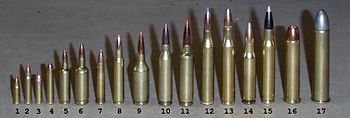
List of rifle cartridges , by primer type, calibre and name.

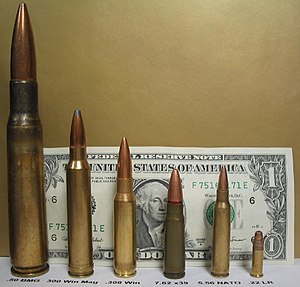

Weatherby, Inc. is an American gun manufacturer founded in 1945 by Roy Weatherby. The company is best known for its high-powered magnum cartridges, such as the .257 Weatherby Magnum, .270 Weatherby Magnum, .300 Weatherby Magnum, .340 Weatherby Magnum and the .460 Weatherby Magnum. The company's headquarters is in Sheridan, Wyoming.
The .416 Rigby is a rifle cartridge designed in 1911 by London based gunmaker John Rigby & Company, for hunting dangerous game. It is the first cartridge to use a bullet of .416 inch diameter. The rifles, as built by John Rigby & Co., were initially made up on the Magnum Mauser 98 action, although in later years, some were made on standard length actions, a perfect example being the rifle used by legendary professional hunter Harry Selby. Other famous users of the cartridge were Commander David Enderby Blunt, John Taylor, and Jack O'Connor.

The .375 H&H Magnum, also known as .375 Holland & Holland Magnum, is a medium-bore rifle cartridge introduced in 1912 by London based gunmaker Holland & Holland. The .375 H&H cartridge featured a belt to ensure the correct headspace, which otherwise might be unreliable, given the narrow shoulder of the cartridge case. The cartridge was designed to use cordite which was made in long strands – hence the tapered shape of the case, which, as a beneficial side effect also helped in smooth chambering and extraction from a rifle's breech.

The 7mm Remington Magnum rifle cartridge was introduced as a commercially available round in 1962, along with the new Remington Model 700 bolt-action rifle. It is a member of the belted magnum family that is directly derived from the venerable .375 H&H Magnum. The original purpose of the belted magnum concept taken from the .300 H&H Magnum and .375 H&H Magnum, was to provide precise headspace control, since the sloping shoulders, while easing cartridge extraction, were unsuitable for this purpose. Improved cartridge extraction reliability is desirable while hunting dangerous game, in particular when a fast follow-up shot is required. The 7mm Remington Magnum is based on the commercial .264 Winchester Magnum, .338 Winchester Magnum, and .458 Winchester Magnum, which were based on the same belted .300 H&H Magnum and .375 H&H Magnum cases, trimmed to nearly the same length as the .270 Weatherby Magnum.
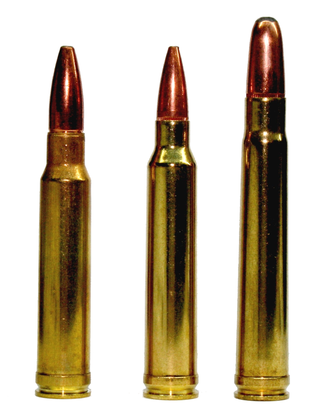
The term belted magnum or belted case refers to any cartridge, but generally a rifle cartridge, with a shell casing that has a pronounced "belt" around its base that continues 2–4 mm (0.079–0.157 in) past the extractor groove.

The 8mm Remington Magnum belted rifle cartridge was introduced by Remington Arms Company in 1978 as a new chambering for the model 700 BDL rifle. The 8mm Remington Magnum's parent case is the .375 H&H Magnum. It is a very long and powerful cartridge that cannot be used in standard length actions, such as those that accommodate the .30-06 Springfield.

The 9.5×57mm Mannlicher–Schönauer (MS) cartridge was adopted for the M-1910 MS rifle and carbine in 1910. The 9.5×57mm MS is also known as the 9.5×56mm MS, the 9.5×56.7mm MS, and the .375 Rimless Nitro Express (RNE) × 2¼. The cartridge may have been created by Westley-Richards and Eley in 1908, but no production rifles in this caliber have been found prior to the M-1910. This development by or on behalf of Steyr was probably an answer to the development by the noted British gunmaking firm of Holland & Holland in 1905 of their .400/375 Belted Nitro Express, designed for their specially modified Mannlicher–Schoenauer rifle. Whether the development of the 9.5×57mm Mannlicher–Schoenauer cartridge originated with OWS or with Holland's British competitor, Westley Richards certainly was the principal promoter of the new 1910 Model Mannlicher–Schoenauer rifle as evidenced by catalogs of the time. The 9.5×57mm MS is the last pre-war proprietary cartridge by Steyr and their most powerful until the recent advent of the .376 Steyr, which has its antecedents in the 9.5×57mm.

The Ruger No. 1 is a single-shot rifle with a Farquharson-style hammerless falling-block action, introduced and manufactured by Sturm, Ruger & Co. since 1967. An underlever lowers the breechblock to allow ammunition loading and also cocks the rifle. Lenard Brownell, commenting on his work at Ruger, said of the No. 1: "There was never any question about the strength of the action. I remember, in testing it, how much trouble I had trying to tear it up. In fact, I never did manage to blow one apart."
The .264 Winchester Magnum is a belted, bottlenecked rifle cartridge. Except for the .244 H&H Magnum and .257 Weatherby Magnum, it is the smallest caliber factory cartridge derived from the 2.85 in (72 mm) Holland & Holland belted magnum case. It was introduced in the late 1950s and early 1960s with the .338 Winchester Magnum and the .458 Winchester Magnum as one of a family of short-cased 2.5 in (64 mm) belted magnum cartridges developed by Winchester based on the .375 Holland & Holland parent case. It was officially introduced to the public by Winchester in 1959. After many years of dwindling use it began enjoying a mild resurgence in popularity in the mid-2000s among long range rifle enthusiasts and reloaders due to the high ballistic coefficient of the heavier 6.5mm bullets and increasing popularity of cartridges such as 6.5mm Creedmoor, .260 Remington, 6.5 Grendel, benchrest and wildcat cartridges in 6.5mm.

The .284 Winchester (7.21x55mmRB) is a rebated rim firearm cartridge, introduced by Winchester in 1963.
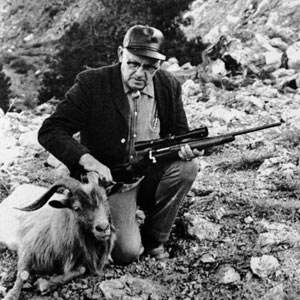
Parker Otto Ackley was an American gunsmith, barrel maker, author, columnist, and wildcat cartridge developer. The Ackley Improved family of wildcat cartridges are designed to be easily made by rechambering existing firearms, and fireforming the ammunition to decrease body taper and increase shoulder angle, resulting in a higher case capacity. Ackley improved not only standard cartridges, but also other popular wildcats, and was the first to create a .17 caliber (4.5 mm) centerfire cartridge.

The .458 Lott is a .458 caliber rifle cartridge designed for the purpose of hunting large, thick-skinned dangerous game animals in Africa. It is based on the full length .375 H&H Magnum case blown out and shortened to 2.800 inches (71.1 mm).
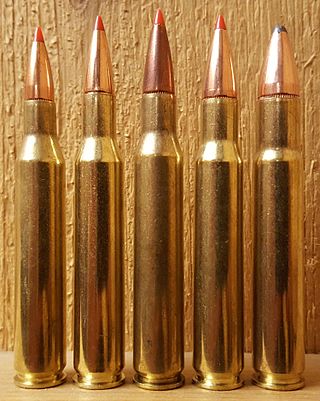
.30-06 Springfield wildcat cartridges are cartridges developed from a 30-06 Springfield "parent cartridge" through narrowing or widening the cartridge neck to fit a smaller or larger bullet in an attempt to improve performance in specific areas. Such wildcat cartridges are not standardized with recognized small arms standardization bodies like the SAAMI and the CIP.

The Blaser R8 is a German straight-pull rifle known for its radially locking bolt system, modularity and its barrel mounted scope mount manufactured by Blaser. The rifle also features a manual cocking system and a direct trigger. In 2015 there had been more than 100,000 complete Blaser R8 rifles produced.
Nosler produces six different rebated rim hunting cartridges. The first to be introduced was .26 Nosler, followed by .28 Nosler, .30 Nosler, .33 Nosler, .22 Nosler, and .27 Nosler.

A fully powered cartridge, also called full-power cartridge or full-size cartridge, is an umbrella term describing any rifle cartridge that emphasizes ballistic performance and single-shot accuracy, with little or no thought to its weight or recoil. They often have a caliber comparable to or greater than 7.5 mm (0.30 in) and a maximum effective range of at least 800 m (870 yd), and are intended for engaging targets beyond 300 m (330 yd). However, cartridges with calibers as narrow as 6.5 mm (0.26 in) have been described as being a full-power rifle cartridge. The term generally refers to traditional cartridges used in machine guns and bolt action and semi-automatic service rifles and select fire battle rifles prior to, during, and immediately after the World Wars and into the early Cold War era, and was a retronym originally made to differentiate from intermediate-power rifle cartridges that gained widespread adoption into military service after World War II.